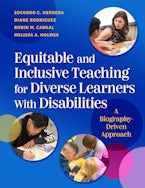ContentsForeword ix
Acknowledgments xiii
Introduction 1
Part I. Historically Centering the Student Through IDEA
1. Searching for Coal in a Gold Mine: Overlooking the Multifaceted Assets of the Learner 7
In Search of Answers 7Beyond a Deficit Perspective: Exploring Gaps in Systems 9The Foundation of an Asset-Driven Agenda 10Conclusion 122. Setting the Stage for Cognitive and Socioemotional Resilience: Reflecting on the Intersection of Policy and Systems 14
IDEA: With the Best of Intentions . . . Have We Arrived? 14Response to Intervention: Moving Beyond Reductionistic Exercises 19Biography: Noticing and Documenting Learner Potential 22Conclusion 23Part II. Applying Biography-Driven Practices in Inclusive Classrooms
3. A Biography-Driven Individualized Educational Plan 27
Moving Beyond Good Intentions Toward Documentable Impact 28Redefining Possibilities Through Equitable Instructional Delivery 33Creating Conditions and Situations for CLD Learners to Thrive 34"My Teacher Made Me Smart" 40Teachers Who See, Teachers Who Know: Observation, Facilitation, and Affirmation 41Building Blocks: Equity and Authentic Cariño 42Conclusion 434. Enriching Opportunities to Learn Through Collaborative Interaction 44
From "Me" to "We": Community Processes and Shared Products 45Maximizing Joint Productive Activity to Respond to the Whole Child 46Fostering Joint Productive Activity Through i+TpsI 52Using BDI Strategies to Guide Interactional Processes 53Conclusion 575. Creating Contexts and Conditions for an Inclusive Community Through Classroom Talk 58
Catalyzing Learning Through Community: Caring and Learning in Action 59Beginning With Biographies: Equity Begins With "i" 60Situationally Speaking: The Ebb and Flow of Reciprocal Talk 63Collaboration: Affirmation as Equity 66Agency "I": Context, Conditions, and Situations 67Conclusion 68Part III. Reimagining Equity for All Learners
6. Real-Life Language Development: A Bridge for Inclusive Classrooms 71
BDI as Treatment Context 72Conclusion 837. The Power of BDI for Students With Low-Incidence Disabilities 85
What's in the Label: Categorizing the Contradictions 85Social Model of Disability, UDL, and BDI 89Conclusion 908. Reframing Our Thoughts and Actions Through an Exceptional BDI Foundation: A Call to Action 93
With Dr. Natasha Reyes and Dr. Leonard Steen Exploring Perspectives of Referring Teachers 95Examining Practices and Perspectives of Child Study Teams 96The Elephant in the Process 98Conclusion 105Glossary 109
Appendix A: Overview of Select BDI Strategies 114
Appendix B: Template for Biography-Driven Goal Development Tool 116
References 117
Index 124
About the Authors 129

